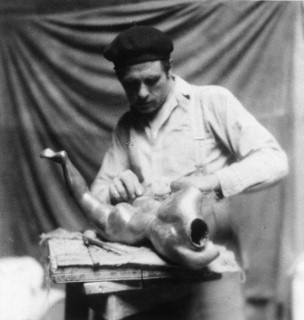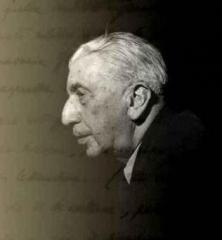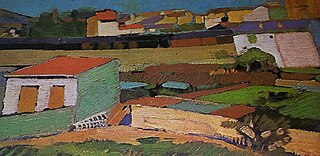Related Research Articles

George Claude Leon Underwood was a British artist, although primarily known as a sculptor, printmaker and painter, he was also an influential teacher and promotor of African art. His travels in Mexico and West Africa had a substantial influence on his art, particularly on the representation of the human figure in his sculptures and paintings. Underwood is best known for his sculptures cast in bronze, carvings in marble, stone and wood and his drawings. His lifetime's work includes a wide range of media and activities, with an expressive and technical mastery. Underwood did not hold modernism and abstraction in art in high regard and this led to critics often ignoring his work until the 1960s when he came to be viewed as an important figure in the development of modern sculpture in Britain.

Piero Manzoni di Chiosca e Poggiolo, better known as Piero Manzoni was an Italian artist best known for his ironic approach to avant-garde art. Often compared to the work of Yves Klein, his own work anticipated, and directly influenced, the work of a generation of younger Italian artists brought together by the critic Germano Celant in the first Arte Povera exhibition held in Genoa, 1967. Manzoni is most famous for a series of artworks that call into question the nature of the art object, directly prefiguring Conceptual Art. His work eschews normal artist's materials, instead using everything from rabbit fur to human excrement in order to "tap mythological sources and to realize authentic and universal values".

Sir John Lavery was an Irish painter best known for his portraits and wartime depictions.

Peter Howson OBE is a Scottish painter. He was a British official war artist in 1993 during the Bosnian War.

Pietro Annigoni, OMRI was an Italian artist, portrait painter, fresco painter and medallist, best known for his painted portraits of Queen Elizabeth II. His work was in the Renaissance tradition, contrasting with the modernist style that prevailed in his time.
William Crozier was an Irish-Scots still-life and landscape artist based in Hampshire, England and West Cork in Ireland. He was a member of Aosdána.
Euan Ernest Richard Uglow was a British painter. He is best known for his nude and still life paintings, such as German Girl and Skull.

Wilfrid Gabriel de Glehn was an Impressionist British painter, elected to the Royal Academy in 1932.

Roberto Longhi was an Italian academic, art historian, and curator. The main subjects of his studies were the painters Caravaggio and Piero della Francesca.

John Ronald Craigie Aitchison CBE RSA RA was a Scottish painter. He was best known for his many paintings of the Crucifixion, one of which hangs behind the altar in the chapter house of Liverpool Cathedral, Italian landscapes, and portraits. His simple style with bright, childlike colours defied description, and was compared to the Scottish Colourists, primitivists or naive artists, although Brian Sewell dismissed him as "a painter of too considered trifles".
Steven Campbell (1953–2007) was a painter from Scotland.

Joan Kathleen Harding Eardley was a British artist noted for her portraiture of street children in Glasgow and for her landscapes of the fishing village of Catterline and surroundings on the North-East coast of Scotland. One of Scotland's most enduringly popular artists, her career was cut short by breast cancer. Her artistic career had three distinct phases. The first was from 1940 when she enrolled at the Glasgow School of Art through to 1949 when she had a successful exhibition of paintings created while travelling in Italy. From 1950 to 1957, Eardley's work focused on the city of Glasgow and in particular the slum area of Townhead. In the late 1950s, while still living in Glasgow, she spent much time in Catterline before moving there permanently in 1961. During the last years of her life, seascapes and landscapes painted in and around Catterline dominated her output.

Francesco Menzio was an Italian painter.
Caziel was a Polish artist who lived and worked in Paris during the inter-war period and who worked alongside a number of important figures of the School of Paris, including Pablo Picasso and the art dealer Daniel-Henry Kahnweiler.

Sir William Oliphant Hutchison LLD PRSA was a Scottish portrait and landscape painter. He was an Honorary Member of the Royal Academy, President of the Royal Scottish Academy and a member of the Royal Society of Arts.

Arturo Checchi was an Italian artist active in Tuscany. His paintings and sculptures are in an expressionist style.

Piero Dorazio was an Italian painter. His work was related to color field painting, lyrical abstraction and other forms of abstract art.
Jan Le Witt (1907–1991) was a Polish-born British abstract artist, graphic designer and illustrator. He had a long professional partnership with George Him. As a design company, Lewitt-Him brought an innovative use of colour, abstraction and symbolism to commercial design. They established a reputation for fine poster work during World War Two and for exhibition displays, most notably with the Guinness clock for the Festival of Britain. The partnership dissolved in 1955 when Le Witt decided to concentrate upon his own, often abstract, art.

Dr. Henry Franz Pulitzer (1899–1979) was an Austrian-born gallery owner and "avid art collector", and connoisseur, described by one source as a "media mogul". He was the owner of the Pulitzer galleries in London and Bern, Switzerland, and of the Isleworth Mona Lisa, a painting famous for the claim passed down from its previous owners that there was evidence that it was painted by Leonardo da Vinci. Pulitzer himself took up the cause of proving the claimed provenance of the painting, including writing a book in support of it, but his efforts did not lead to acceptance of the claim during his lifetime.

Alfred Ernest Egerton Cooper, RBA, ARCA, was a British painter of portraits, landscapes and other figurative work. In the era of Modernism, he continued to work in traditional style from his studio in Chelsea, London.
References
- ↑ url=https://pms.wikipedia.org/wiki/Pietro_Giacinto_Angelo_Sansalvadore | access-date=30 June 2024
- 1 2 3 4 5 6 "Letter from Piero Sansalvadore to Mrs. Vahdah Olcott Bickford, March 11, 1947". digital-collections.csun.edu. Retrieved 1 August 2021.
- ↑ "La leggenda della castellana: gavottina all'antica per violino con accompagnamento di pianoforte". opac.sbn.it. Retrieved 1 August 2021.
- ↑ Piero Sansalvadore, How and why I gave up brushes. The Studio, vol 108, no 496, July 1934.
- ↑ The Scotsman, 6 December 1932, p 11.
- ↑ Nottingham Journal, 5 December 1938, p 4.
- ↑ "Royal Collection Trust". www.rct.uk. Retrieved 1 August 2021.
- 1 2 3 They Knew Peiro Sansalvadore, Kensington Post, 12 August 1955, p 5.
- ↑ Gloucestershire Echo, 5 November 1945, p 3.
- ↑ Kensington Post, 29 May 1953, p 1.
- ↑ The Birmingham Post, 30 July 1955, p 5
- ↑ "Vôs de la guera, (Giugno 1916-Giugno 1917)". discover.libraryhub.jisc.ac.uk. Retrieved 1 August 2021.
- ↑ "Art UK – Pietro Sansalvadore". artuk.org. Retrieved 14 February 2024.